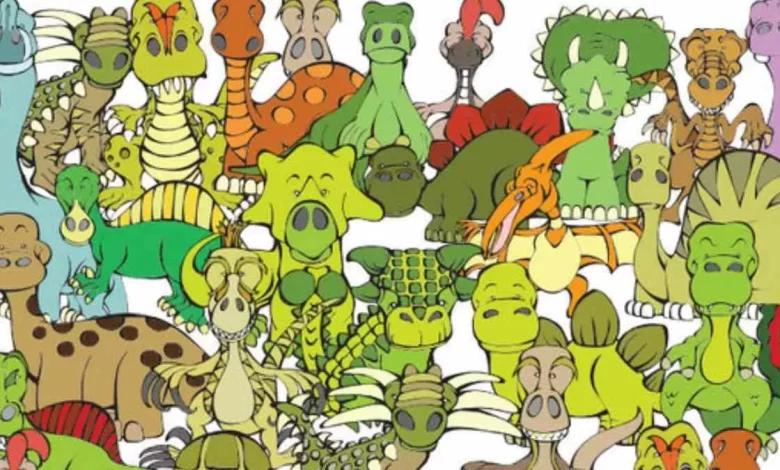Spot The Hidden Turtle: Only 1% Can Spot The Hidden Turtle Among Dinosaurs In Picture Within 9 Secs!

Spot The Hidden Turtle: Only 1% of people can solve this optical illusion test. Can you spot the hidden turtle among the dinosaurs in the picture within 9 seconds?
Optical Illusion for IQ Test
An optical illusion is a mind-bending, deeply fascinating, shape-shifting image of an object or drawing or people that challenges the brain’s way of perceiving things. You must have seen many types of optical illusions like physical, physiological, and cognitive illusions.
Spot The Hidden Turtle, Studies reveal that optical illusions are also a part of the field of psychoanalysis that throws light on how you perceive things. A normal human brain can look at things or images differently forming a different perception from each angle. One such clever illustration can be seen in the image where a turtle is hiding among the dinosaurs in the picture.
Optical Illusion for IQ Test: Only 1% can spot the hidden Turtle among the Dinosaurs in the picture!

Image Source: Playbuzz
Spot The Hidden Turtle, The above image has been shared as a picture puzzle for children and adults. In this optical illusion, you can see different kinds of dinosaurs in the picture. The illusion challenges the viewers to find the turtle hidden among the dinosaurs inside the picture. It has been claimed that only 1% of people can find the hidden turtle in this image. This optical illusion image is just another fun way to test your IQ. However, taking an actual IQ test is a good way of knowing your IQ level.
Did you spot the hidden turtle in 9 seconds?
Spot The Hidden Turtle, If you are finding it difficult to spot the hidden turtle, then we are here to help! If you look carefully at the center-left side of the image, you will see a turtle hiding between the group of dinosaurs. This optical illusion could reveal just how good your eyesight is. For your ease, we have highlighted the hidden turtle under the sea in the image given below:

Image Source: Playbuzz
Spot The Hidden Turtle, The green body of the turtle has been cleverly camouflaged with the dinosaurs. The image has left thousands of adults scratching their heads as they try to spot the turtle hidden in the image. Studies show that the more you exercise your brain with difficult puzzles, the smarter you tend to be.
Optical illusions always give some fascinating insight into how our brains work. Specific combinations of colour, light, and patterns can trick our brains into visually perceiving something that isn’t there. So tell us, did you spot the turtle hidden inside this optical illusion image?
You can always view and study more brain teaser, intellectual games, puzzles and personality tests in the entertainment section of Chashmak Website. Share them with your friends if you like. Especially those who are interested knowing themselves better and having fun. Follow us on Instagram and Facebook and share your comments and suggestions.
Optical Illusion -FAQs
1.What is Optical Illusion?
Hidden Butterfly Optical Illusion, Optical Illusion or visual Illusion is an illusion caused by the visual system. It is characterized by a visual perception that appears to differ from reality.
2.How do Optical Illusions deceive us?
Optical Illusion is a visual deception where we get deceived by what we see or misunderstand the thing we saw. Optical Illusion deceives and confuses people by playing with color, light, and patterns.
3.What are the categories of Optical Illusion?
Hidden Butterfly Optical Illusion, Optical Illusion is said to be categorized into three types such as physical, physiological, and cognitive illusions.
Benefits of Optical Illusions
Entertaining and Fun
First of all, optical illusions can be fun. This can reduce stress, improve your mood and enhance relaxation.
Exercising The Brain
Research has shown that by exercising the brain, neural pathways are maintained, or enhanced. Such brain exercise can help to improve student alertness and performance on exams. There are therapeutic benefits to people with developmental disabilities as a brain therapy. There also is research indicating that symptoms of dementia or Alzheimer’s disease may be reduced and regression slowed through brain exercises.
Optical illusions also can challenge our perceptions and cognitive abilities, helping to improve our mental acuity and cognitive flexibility.
Therapy
They can be used therapeutically to help people with certain conditions, such as amblyopia (lazy eye), to improve their visual perception.
Given these benefits of visual illusions, what are the detriments? Some people may experience dizziness or eye strain, but the most common disadvantage is just frustration. After all, sometimes it can be tricky to find the illusion or hidden image.
Overall, optical illusions can be a fun way to engage with our visual perception and enhance our cognitive abilities.




